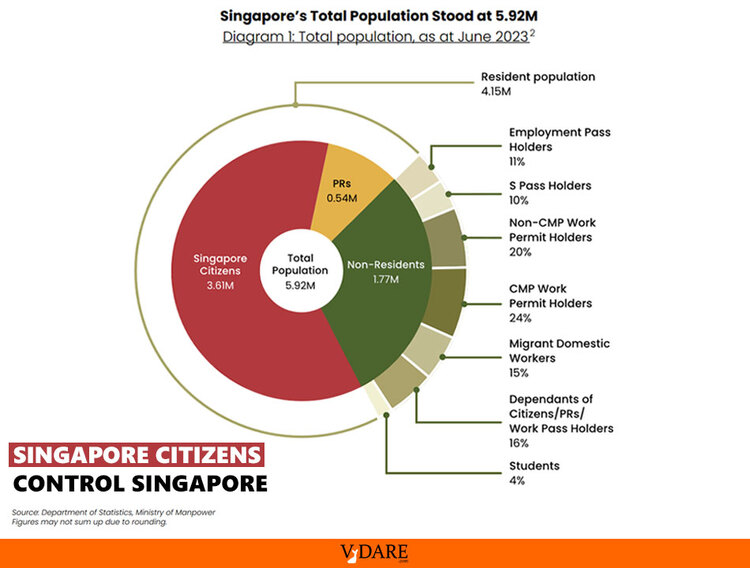See also: Even If Immigration Continues, The Sailer Strategy Could Still Win It For The GOP In 2050, by Steve Sailer, September 9, 2009
First World societies are not the only ones experiencing nation-breaking immigrant inflows. Many countries, whether deliberately or because of mass illegal immigration, have undergone profound changes that have serious implications for their politics. One of the most notable examples: the British-created, Chinese-majority island Republic of Singapore. Singapore’s reaction: don’t let immigrants (or their children) vote!
Singapore, born out of a dispute with ethnic Malay-dominated Malaysia, of which it was a part prior to 1965, has a great deal of resident foreigners who were invited in to propel its economic growth and industrial development.
The population of Singapore, composed of some 5.9 million people as of June 2023, has a non-citizen population of 2.3 million people representing 40% of the Republic’s overall total These non-citizens, comprising roughly 1.7 million “residents” and 538,000 “permanent residents” do not have the right to vote, change state policy, or participate with the Singaporean political system in any meaningful way.
This is a fine balance: Voting-age Singaporean citizens represent only 2.7 million individuals, just 400,000 less people than the entire non-citizen population.
For comparison to a Western country: the best example would be Switzerland. The Swiss sport a foreign-born population of some 30.7% representing roughly 2.7 million people. Only a small portion of this foreign-born population has been naturalized. The total non-citizen population comprises 2.2 million individuals representing 25.7% of the population.
Both these countries also maintain similarly stringent naturalization laws for their immigrant populations, laws deliberately designed to keep these populations away from the levers of state power.
Thus the Swiss require that a foreigner have lived in the country for a period of ten years. The Singaporeans require that foreign permanent residents have lived in their country for 10 of the 12 years preceding a citizenship application.
While both countries maintain stringent general requirements, they do reduce requirements for the spouses of their own citizens—although, interestingly, Singapore only grants spousal naturalization to foreign-born wives, not foreign-born husbands.
Crucially, neither Republic allows Birthright Citizenship [Swiss government rejects automatic citizenship for those born in Switzerland, Le News, June 17, 2022].
This means there is a significant population of native-born non-citizens. Neither Republic cares.
These stringent systems of naturalization contrast dramatically with the American system, which grants permanent residency in a number of months (often issued by courts or bureaucratic tribunal) and then citizenship a mere 5 years later. The American system admits new citizens, and therefore political participants, in less than half the time which it takes the Singaporean system and does so with far fewer requirements.
And, crucially, the America system allows Birthright Citizenship, by which the children of non-citizen immigrants (even if illegal) are automatically citizens—ending which is the “Internal Wall” against demographic dispossession.
The U.S. is also catching up to the Singaporeans in the share of the foreign-born population. The Census Bureau projects that by 2100 the foreign-born population of the U.S. will be 24.4%, the highest ever recorded. This is likely an underestimate as the Census Bureau continually understates both population growth and the foreign-born population of the U.S. in non-census years.
Singapore and the U.S. are also similar when it comes to the population that resides in the country vs. the population which votes in the country. While Singapore is just shy of parity between its voting citizenry and its foreign resident population, several U.S. states already sport a massive divergence between residents and voters. California is just 35% White, but the state’s electorate is wildly divergent: Whites comprise 55% of its voters as of 2020, while Hispanics, representing 39% of the state’s population, represented only 21%.
Minority special interest groups in the U.S. whine that the American electorate is increasingly non-reflective of the county’s immigration-driven demography [The Changing Face of America’s Electorate: Political Implications of Shifting Demographics, by Patrick Oakford, American Progress, January 6, 2015]. And Legacy Americans increasingly realize that demographic change will affect elections.
Similarly, Singaporeans worry that the massive foreign population will have a negative effect on their influence over their own polity. They have consistently protested and voted against the government’s various “population plans” which would see the foreign population of the nation continue to increase over time, thereby reducing Singaporeans to an absolute minority in their own state [Singaporeans protest plans to increase immigration, by Liz Nesloss, CNN, February 16, 2013).
But these protests brought about a raft of policy changes which saw the Singaporean state alter the immigration process, and the nature of those who get admitted to the country, in the mid-2010s [Singapore Immigration and Changing Public Policies, Association for Asian Studies, Winter 2017].
Because of these changes, the racial and demographic mix of Singapore has held steadily for the past 13 years, effectively reducing worries that the Singaporean population would be swamped.
Similar anti-immigration and anti-demographic change movements have been taking place in other countries, such as the aforementioned Switzerland, covered in this piece by the prolific John Derbyshire.
Of course, an electorate that does not correspond to the whole of the population can pose unique challenges, especially when it comes to the provision of goods and services for the large non-citizen populations.
But this divergence can also provide ample additional time to reduce immigrant inflows, change nationality laws to prevent more naturalizations and, crucially, to reverse Great Replacement migration.
James Karlsson (email him) is the founder and director of the White-Papers Policy Institute. Read them on Substack, follow them on Twitter, and message them on Telegram.













